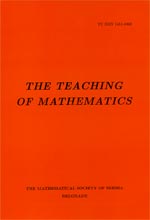
| Structuring systems of natural, positive rational, and rational numbers |
| Milosav M. Marjanović and Zoran Kadelburg |
Abstract In this paper, we are concerned with the extensions of the system $N$ of natural numbers with $0$ to the system $Q_+$ of positive rational numbers with~$0$ and then, the extension of this latter system to the system $Q$ of rational numbers. Structuring these systems, we start with the system of natural numbers forming the list of its basic operative properties (i.e\. the properties of operations and the order relation) and using only these postulated properties, we deduce from them a series of properties of proportions and equalities that relate differences. While deducing, we suppose that all involved ratios and differences are defined in~$N$, i.e. they have the value which is a natural number.\par Keeping in mind these properties, we define equivalence of arbitrary ratios (without supposing their values in~$N$) and then, we extend the meaning od addition, multiplication and order relation to the equivalence classes of these ratios. Thus, the system of positive rational numbers with $0$ is constructed and the list of its basic properties is accomplished.\par Comparing this new list and that with properties of~$N$, two lists are identical except that the variables are denoted by different letters and the new list contains an item more: the existence of multiplicative inverse. Omitting this item, two systems become formally identical. Therefore, they have the same postulated properties, as well as those deduced from them. This is a precise formulation of the Peacock's principle of permanence, telling which properties are transferable and it is also the way of its logical justification.\par Similarly, $Q_+$ is extended by equivalence classes of formal differences in $Q_+$ and addition, multiplication and the order relation are defined in this set of equivalence classes. Thus, the system $Q$ of rational numbers is constructed and the list of its basic properties accomplished. Taking the operative properties of the systems $N$, $Q_+$ and $Q$ as axioms, the $N$-structure, $Q_+$-structure and $Q$-structure (standardly called the ordered field) are defined, respectively. Since the axioms of $N$-structure are least restrictive, it follows that the systems of positive rational and rational numbers and of real numbers are examples of $N$-structure. Thereby, all operative properties of $N$ and those deduced from them are also valid in these number systems, when they are transcribed writing corresponding variables. This is the necessary precision and logical justification for the Peacock's principle of permanence.\par At the end, we prove that each system satisfying axioms of $N$-structure contains an isomorphic copy of the system $N$ with $0$, what characterizes the system of natural numbers with $0$ as the smallest system satisfying the axioms of $N$-structure. |
Keywords: Natural numbers; positive rational numbers with zero; rational numbers; Peacock's principle of permanence; characterizing properties of the system of natural numbers with zero. |
Pages: 1$-$16 |
Volume XXII , Issue 1 , 2019 |
